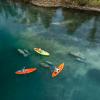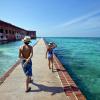The town of Zephyrhills is home to Skydive City, one of Florida’s largest skydiving facilities.
- Lauren Tjaden for VISIT FLORIDA
St. Pete Beach promises soft white sand and emerald-hued waters.
- Lauren Tjaden for VISIT FLORIDA
Central West
Central West Florida offers the big-city lures of Tampa, Clearwater, and St. Petersburg, but is also home to magnificent beaches, wildlife, clear springs, and scenic rivers.
Brandon
Brandon might be a bedroom community for Tampa, but it doesn’t have to be a sleeper – shoppers will squeal over discounts at the HSN Outlet and should schedule quality time with Westfield Brandon, a retail giant with great choices in restaurants, too. Outdoor pursuits draw visitors to the edge of town, where elevation changes created by an old phosphate mine enable off-road biking at Alafia River State Park. Close by, a dip into 72-degree Lithia Springs cools you off.
Brooksville
Ready to connect with your inner 19th century? Look for the gingerbread trim of the May-Stringer Hernando Heritage Museum (built in 1856). Outside town, gear up for Croom Motorcycle Area, Florida’s only state-run, off-road park inside Withlacoochee State Forest.
Clearwater and Clearwater Beach
There’s plenty to do off the beach here (catch touring comedians, rock legends and musicals at Ruth Eckerd Hall; Philadelphia Phillies’ spring training at slick Spectrum Field), but the Gulf will call, and you should answer. On the way, Coachman Park offers views of Clearwater Harbor and open-air concerts, like the annual Clearwater Jazz Holiday. Cross the nearby Memorial Causeway to reach Clearwater Beach. A roundabout leads to Pier 60, Clearwater Municipal Marina and Mandalay Avenue, where you can participate in a nightly sunset celebration, board a pirate cruise or fishing charter, and enjoy souvenir shopping and a grouper sandwich, steps from the Gulf.
Crystal River
Citrus County harbors two national wildlife refuges awakens the naturalist in its visitors. Chassahowitzka National Wildlife Refuge, a wonderland of salty bays, estuaries and marshes mingling with the Chassahowitzka River, is accessible only by boat. Come for the fishing, crabbing and wildlife viewing. Inside Crystal River National Wildlife Refuge, manatees are the highlight (in fact, the refuge was created for their protection). Local guides operate snorkeling, scuba, boat and kayak tours for sighting; the best months are October through March, when manatees migrate here to escape chilly winter waters.
Dade City
Its name may be citified, but this is quintessential small-town Florida, rooted in citrus and boasting a downtown with an eye for the antique (in its boutiques and architecture). Explore the Pasco County Courthouse, renovated to its 1909 glory, and Church Street, lined with 19th-century (you guessed it) churches. Downtown’s plate is full of restaurants and shops, while the Pioneer Florida Museum transports you to Dade City past, with a 1930s schoolhouse among its collection of historic buildings. Annually, the Kumquat Festival (January) and the Little Everglades Driving Event (March) give a nod to the area’s citrus heritage and outdoorsy sensibility.
Dunedin
This is a best-of-both-worlds kind of place; its waterfront downtown is packed with original restaurants, shops and artsy stops. The 38-plus-mile Pinellas Trail cuts through, with access to Dunedin’s bike rentals and refreshments. The No. 1 beach in the nation in 2008 (according to Dr. Stephen P. Leatherman, a.k.a. Dr. Beach), Caladesi Island State Park, lies off the coast. Take the ferry or a private boat from Honeymoon Island State Park to experience it, though the sight of striated blue water meeting sky is equally spectacular within both parks. Need another reason to love Dunedin? Its Scottish heritage brings an annual Celtic festival and Highland games.
Indian Rocks Beach and Indian Shores
You’ve got the Intracoastal to one side, the Gulf of America to the other. Any way you look at it, you’ve got it made in these cozy beach communities. Think residential, with plenty of public beach access and a handful of parks (take a boardwalk trek through mangroves to reach the fishing pier at Town Square Nature Park). The nonprofit Suncoast Seabird Sanctuary has been caring for wild birds since the 1970s; visit the hospital and rehab center for a look at its 600 or so residents.
Madeira Beach
This is the stuff beach boardwalks are made of: waterfront eats, a marina packed with choices for dipping into the aqua and even a pirate ship where you can wage your own squirt-gun battles. (It’s a nod to Madeira’s first rumored settler, a pirate named John LeVique. He’s also the inspiration for the community’s Pirate Days Festival, though its long-running October seafood festival attracts a crowd, too). The action centers on John’s Pass Village and Boardwalk, where you can shop, eat or watch dolphins and pelicans come and go. The beach awaits just across the street.
New Port Richey
It didn’t become the “Hollywood of the East” movie moguls hoped it would in the 1920s, but a mural at the corner of Main Street and Grand depicts New Port Richey’s almost-famous past. Let the town’s Main Street Association fill in the details on a walk tour, and check out the Richey Suncoast Theatre, commissioned by silent film star Thomas Meighan. Designated as a Florida Main Street community, New Port Richey is full of character, with changing exhibits inside the Progress Energy Art Gallery, antiques shops and the like. Water wields its influence with the Pithlachascotee River winding through town (call it the Cotee to sound like a local) and a 320-foot-deep spring bubbling inside Werner-Boyce Salt Springs State Park.
Redington Beach and North Redington Beach
Redington and North Redington are residential communities, with few residents at that. A handful of parks, restaurants and accommodations is all it takes to keep the communities going – residents and repeat visitors love these locales for their intimacy. Redington’s causeway invites fishing, and several small parks show off native plantings. North Redington’s beach accesses and accommodations are easy to find. The Suncoast Beach Trolley transports sunbathers to both.
Safety Harbor
The charming enclave of Safety Harbor promises picturesque waterfront parks, spoil-you-silly accommodations at Safety Harbor Resort & Spa, and a walkable main street brimming with shops, galleries, and eclectic eateries. Explore the boardwalk, marina, and fishing pier; raise your glass at Crooked Thumb Brewery, complete with a beer garden and live music; or check out cultural offerings like Safety Harbor Museum & Cultural Center, Syd Entel Galleries, and Safety Harbor Art and Music Center.
St. Pete Beach
There’s more to St. Pete Beach than the Don CeSar, a luxury resort where many a celebrity has slept since its opening in 1928. In fact, St. Pete Beach offers up a variety of accomodations, but the small-town feel isn’t lost. Spend some time along Corey Avenue, browsing boutiques, sampling restaurants and mingling with the locals at events such as wine tastings and an annual arts and crafts festival. Corey Avenue is book-ended by the Gulf and Boca Ciega Bay, so you can count on established waterfront restaurants. And do pay the Don CeSar a visit – its palatial pink profile is iconic along these bright-white shores.
St. Petersburg
Part culture, part nature – that’s St. Petersburg. Downtown is where the arts are, with several galleries and five museums (the Salvador Dalí Museum houses the largest collection of the surrealist’s work outside of Spain). There’s boutique shopping, but performing arts and music venues (plus a new wave in restaurants and nightclubs) really keep things buzzing. The excitement amps up during the Firestone Grand Prix in March, racing past glittering Tampa Bay and green spaces that host regular fetes like the Mainsail Arts Festival. For all of its sophistication, St. Petersburg is just as revered for its beaches (TripAdvisor named Fort De Soto Park’s beach North America’s best in 2008 and 2009), fishing (try the Skyway Pier any time of day or night) and kayaking (during the winter, see roseate spoonbills through the mangroves inside Weedon Island Preserve).
Tampa
Tampa’s to-dos are a reflection of its melting-pot influences. In 1886, Vicente Martinez Ybor visited this city and decided to set up his Cuban-born cigar empire here. Ybor City, with its signature street lamps, wrought-iron balconies and brick streets, tells the story. By day, take the walking tour from Ybor City Museum State Park. Nights reveal flamenco dancers at The Columbia Restaurant, established in 1905, and a bar scene. Downtown is a sight from the mystical minarets of the circa-1891 Tampa Bay Hotel (now the Henry B. Plant Museum and The University of Tampa) to attractions like the Channelside District, where you can watch NHL’s Tampa Bay Lightning at the Amalie Arena or visit the Florida Aquarium. North of downtown, the Tampa Bay Buccaneers bring NFL action and Busch Gardens adds theme park thrills to the mix.
Tarpon Springs
Tarpon Springs was settled in the mid-1800s, as the railroad brought visitors from the north. Greek sponge divers later developed Tarpon Springs' famed sponge diving industry in the very early 1900s. Greek divers, who originally settled in the Keys, found they could harvest the more desirable wool sponges in the deeper and colder waters of the Gulf of America. The atmosphere here is still heavily Greek – and there is still plenty to do to celebrate sponging, like strolling the sponge docks along the Anclote River and observing a live sponging exhibition. When it’s time to eat, you gotta go Greek. Then, venture into the adjacent downtown (it’s listed in the National Register of Historic Places) for more food, plus art galleries and specialty shops. St. Nicholas Greek Orthodox Cathedral, a replica of St. Sophia Cathedral in Constantinople, welcomes visitors, too.
Zephyrhills
You might miss it mid-freefall (the town is home to Skydive City, one of Florida’s largest skydiving facilities), but Zephyrhills maintains a pastoral feel, with ranch, farm and citrus groves all around. Emphasizing the unchanged, the Zephyrhills Depot Museum shares city history and railroad memorabilia inside the restored 1927 Atlantic Coast Line Railroad depot. And yes, the spring water is bottled here.
For Central West Florida and other Florida travel ideas, go to VISIT FLORIDA's official travelers guide.


























